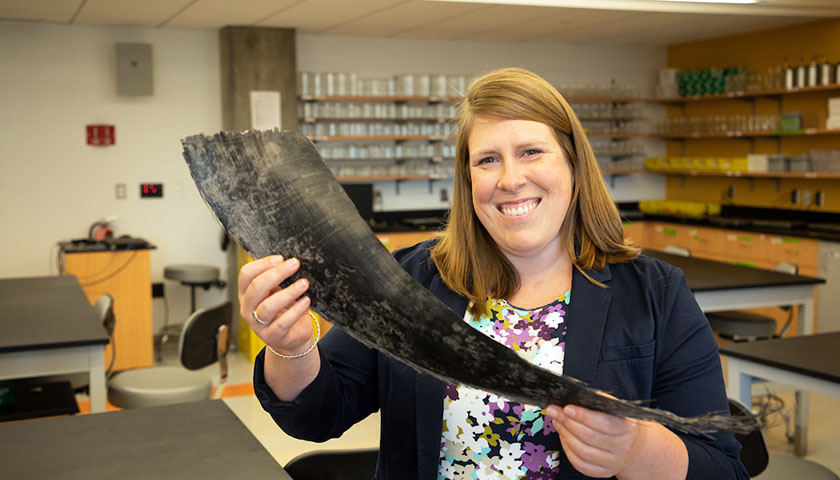The right whale population is plummeting, and Suffolk Biology Professor Nadine Lysiak is delving into the stresses placed on them as part of an effort to preserve these giants of the sea.
“The species is in crisis,” said Lysiak, whose research is focused on marine ecology.
There are only 411 North Atlantic right whales in U.S. and Canadian waters, according to the North Atlantic right whale catalog, maintained by the New England Aquarium, and researchers have documented 28 deaths in just the past three years, according to Lysiak.
“That is not sustainable,” she said. “Birth rates have also been low in recent years. The whales are not replacing themselves fast enough to survive. For such an endangered species, every birth and death is significant if we want them on the road to recovery.”

Human impact
Many recent whale deaths have been connected to human activities, with whales either struck by vessels or fatally entangled in fishing gear.
“If people could see these animals entangled, they would protest and demand change,” she said.
When a North Atlantic right whale dies, a team of researchers brings it to shore and performs a necropsy. As part of the process, they remove the whale’s baleen, the bristly food-filtering plates that hang from a whale’s upper jaw, and immediately send it to Lysiak.
When she receives the baleen, it’s covered in oil, blood, sand, and more.
“It’s disgusting and smells bad,” said Lysiak, so the first thing she does when opening a baleen package is to arm herself with a scrub brush and a bottle of shampoo. She thoroughly cleans the baleen for several hours before beginning to conduct her research in the Suffolk lab.
Retracing a whale’s challenges through baleen
She dissects the baleen plates, which are made of keratin, a protein also contained in the human hair and fingernails. One of Lysiak’s goals is to provide quantitative data around the stress physiology associated with fishing gear entanglements.
In the Media
“My research gives us information about when and potentially where gear entanglements began,” she said. “It also gives an indication of the animal’s physiological reaction to the gear, as well as its feeding success during the entanglement period.”
Lysiak also hopes her research answers basic questions regarding the reproductive physiology of right whales. “We study the whales’ reproductive hormones, but there is a lot about their lives that we don’t understand,” she said.
“We estimate that whales are pregnant for about 13 to 18 months, but we’re always searching for information about when and where they become pregnant, how many calves they have, and what is their success rate over time.”
Research and learning
Lysiak includes lessons about the North Atlantic right whale in her courses because she believes the species is an interesting case study “on the complexities of natural resource and species management in the modern age.”
And Lysiak is always looking to recruit interested students to work in her lab.
“Besides using a variety of ecological techniques to study right whales, I also want to use them as a forensic method to investigate the lives and deaths of other marine mammal species,” she said. “Through independent research projects, Suffolk students will be an integral part of this work.”



